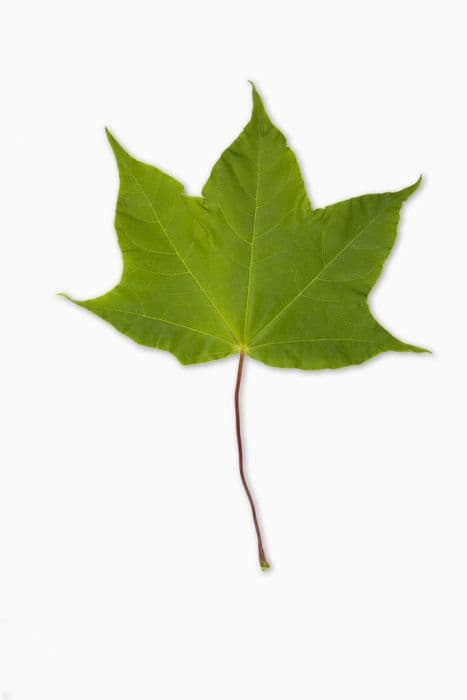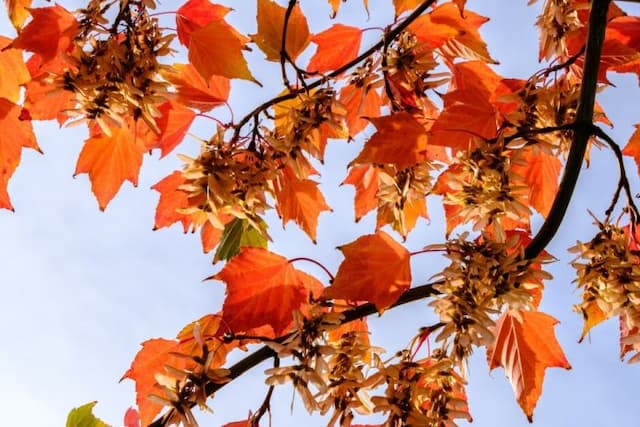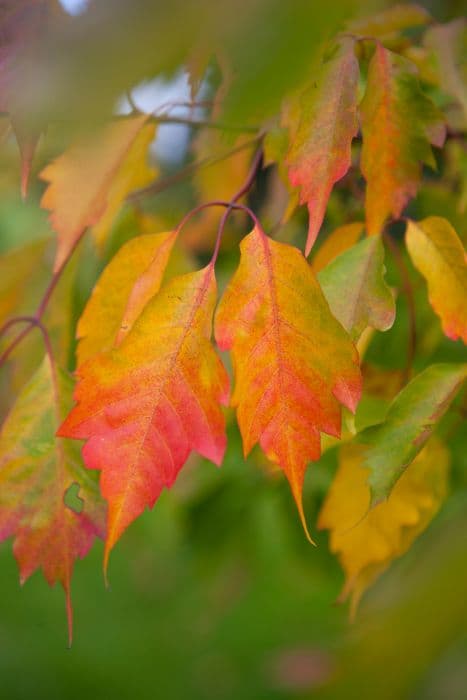Norway Maple Acer platanoides 'Walderseei'

ABOUT
The Norway maple 'Walderseei' is an ornamental tree known for its distinctive and aesthetically pleasing features. The tree showcases a canopy of foliage that presents a beautiful variety of colors throughout different seasons. The leaves are deeply lobed, much like the classic maple leaf emblem, and they exhibit a striking color transition from bright green in the spring and summer to a mesmerizing array of yellows and sometimes reddish-bronze hues in the autumn. One of the most special attributes of the 'Walderseei' variety is its variegated leaves. The foliage is marked with a blend of green and creamy white or sometimes light yellow margins that give the tree a speckled appearance from afar, and upon closer inspection, this variegation is seen as an elegant patterning that adds to the tree's ornamental value. The leaves are smooth to the touch and grow opposite each other on the branches. The tree produces small flowers in the springtime, which are typically yellow-green and may not be as noticeable as the striking foliage. By the late summer or fall, the flowers give way to the production of samaras, which are the characteristic winged seeds of maple trees. These seeds start off green before maturing to a light tan or brown color, and they can often be seen twirling to the ground when they detach. The bark of the 'Walderseei' Norway maple is another significant feature, providing a backdrop to the vibrant foliage with its grayish-brown color and textured surface that can become more rugged with age. The tree overall has a well-structured shape, which is often rounded or oval, lending it a robust and classic tree silhouette that is appreciated in landscapes for visual interest and shade. The variegated Norway maple 'Walderseei' is a sought-after variety for its decorative leaves and year-round visual appeal, making it a popular choice for gardens, parks, and streetscapes where its colorful presence can truly stand out.
About this plant
 Names
NamesFamily
Sapindaceae.
Synonyms
Norway Maple 'Walderseei'.
Common names
Acer platanoides 'Walderseei'.
 Toxicity
ToxicityTo humans
Norway maple ('Walderseei' is a cultivar) is not generally known to be toxic to humans. There are no significant reports of poisoning after ingesting parts of this plant. However, as with many plants, individual allergic reactions or irritation can occur, and it's advisable to avoid ingesting plant material that is not commonly recognized as food.
To pets
Norway maple is not typically considered toxic to pets. While ingestion of parts of the plant is unlikely to cause serious poisoning, it can potentially cause gastrointestinal upset, such as vomiting or diarrhea, particularly if ingested in large quantities. As with any non-food plant, it's generally best to prevent pets from consuming it to avoid any possible adverse effects.
 Characteristics
CharacteristicsLife cycle
Perennials
Foliage type
Deciduous
Color of leaves
Varied
Flower color
Yellow-green
Height
20-30 feet [6-9 meters]
Spread
20-30 feet [6-9 meters]
Plant type
Tree
Hardiness zones
4
Native area
Europe
Benefits
 General Benefits
General Benefits- Shade provision: The tree's canopy offers cooling shade which can reduce the need for air conditioning in nearby buildings.
- Ornamental value: With its attractive foliage, seasonal flowers, and striking form, it adds aesthetic value to landscapes.
- Wildlife habitat: It provides food and shelter for various species of birds and insects.
- Environmental impact: The tree plays a role in carbon sequestration, helping to mitigate climate change.
- Erosion control: Its root system can help stabilize the soil and prevent erosion.
- Windbreak: When planted in groups, these trees can serve as a windbreak, protecting against strong winds.
- Community enhancement: Acer platanoides 'Walderseei' can contribute to the overall green space of a community, enhancing liveability.
 Medical Properties
Medical PropertiesThis plant is not used for medical purposes.
 Air-purifying Qualities
Air-purifying QualitiesThis plant is not specifically known for air purifying qualities.
 Other Uses
Other Uses- Woodwork – The wood of the Norway maple is not commonly used due to its tendency to crack during drying, but it can be utilized for small woodturning projects and ornamental woodworking.
- Photography – The vivid foliage of 'Walderseei' in the autumn can serve as a stunning natural backdrop for outdoor portraits and landscape photography.
- Urban Challenges – The hardy nature of this cultivar allows it to survive in urban conditions, making it useful for educational programs that focus on urban horticulture and challenges faced by plants in cities.
- Habitat Support – While not a native species, the dense foliage of the tree provides shelter and nesting sites for birds and other small urban wildlife.
- Educational Tool – Schools and universities might plant 'Walderseei' to teach students about botany, cultivar development, and the adaptation of non-native plants in an ecosystem.
- Seasonal Celebrations – The Norway maple can be decorated with lights and ornaments, to celebrate seasonal events, similarly to what is typically done with coniferous trees.
- Leaf Casting – Craft enthusiasts can use the leaves from the 'Walderseei' to create decorative leaf castings for art projects and garden ornaments.
- Permaculture – Although non-native, when used responsibly, the tree can be incorporated into permaculture designs that value the shade it provides and its tolerance to various soil conditions.
- Maple Syrup Experimentation – Although not the preferred species for syrup, the Norway maple's sap can be used for educational purposes to demonstrate the process of making maple syrup.
- Soil Improvement – Leaf litter from the Norway maple can be composted and used to improve soil structure and fertility in gardens and landscapes.
Interesting Facts
 Feng Shui
Feng ShuiThe Norway Maple is not used in Feng Shui practice.
 Plant Symbolism
Plant Symbolism- Strength and Endurance: The 'Walderseei', a cultivar of the Norway Maple, symbolizes strength and endurance due to its robust and hardy nature that enables it to thrive in various climates.
- Longevity: As Norway Maples can live for many years, they represent longevity and the passage of time.
- Protection: The canopy of the Norway Maple provides shelter and shade, signifying protection and safety.
- Growth and Expansion: The quick-growing nature of this plant symbolizes personal growth and expansion.
- Adaptability: The plant's capacity to adapt to different environments mirrors the human characteristic of adaptability to life's changing circumstances.
 Water
WaterNorway maple 'Walderseei' should be watered thoroughly, allowing the soil to become moist but not soggy. During the first growing season, it's crucial to maintain a consistent moisture level to establish a strong root system, which may mean watering once or twice a week depending on climate and soil drainage. After establishment, it can tolerate some drought, but it is still advisable to give it a good soak every two weeks during dry spells. During the hot summer months, you might need to increase the frequency, ensuring that you provide about 1-2 gallons per watering for young trees, while mature trees may require 10-15 gallons every few weeks to maintain health.
 Light
LightThe Norway maple 'Walderseei' thrives best in full sun to partial shade conditions. Ideal light conditions would involve at least 4-6 hours of direct sunlight each day. The plant can tolerate some shade, although it may not grow as vigorously or produce as vibrant foliage coloring. To achieve optimal growth, plant your Norway maple in an area where it will receive ample morning sunlight and some afternoon shade, especially in hotter climates.
 Temperature
TemperatureThe Norway maple 'Walderseei' is hardy and can withstand a wide range of temperatures, typically growing well in USDA zones 4 through 7. It can survive minimum winter temperatures down to around -30°F and is tolerant of summer highs up to about 90°F. The ideal temperature range for this tree would be between 50°F and 75°F. It is not suited for tropical climates where temperatures consistently exceed this range.
 Pruning
PruningPruning the Norway maple 'Walderseei' is generally done to remove any dead, diseased, or crossing branches to maintain the tree's health and appearance. The best time to prune is during the dormant season, typically late winter or early spring, to avoid sap flow which can attract pests. Pruning once a year is usually sufficient, and occasional thinning may be needed to allow light and air to penetrate the canopy, improving vigor and reducing the risk of disease.
 Cleaning
CleaningAs needed
 Soil
SoilNorway Maple 'Walderseei' thrives best in a well-draining soil mix with a slightly acidic to neutral pH range of 5.5 to 7.5. A mix composed of loam, compost, and sand or perlite would be ideal, providing the necessary nutrients and structure for healthy root growth.
 Repotting
RepottingNorway Maples like 'Walderseei' do not require frequent repotting and often do well when left undisturbed. They should be repotted every 3 to 5 years or when they become root-bound.
 Humidity & Misting
Humidity & MistingNorway Maple 'Walderseei' is adaptable and can tolerate a wide range of humidity levels; however, it performs best in average outdoor humidity conditions.
 Suitable locations
Suitable locationsIndoor
Not suited for indoor growth; requires outdoor conditions.
Outdoor
Plant in well-draining soil, full sun to partial shade.
Hardiness zone
4-7 USDA
 Life cycle
Life cycleThe Norway Maple 'Walderseei' begins its life cycle as a dormant seed that requires stratification (period of cold) to break dormancy. Upon sprouting in the spring, the seedling emerges and begins to grow, developing a root system and a stem with characteristic lobed leaves. As the tree sapling matures over several years, it establishes a sturdy trunk and a broad crown with dense foliage, turning into an adult tree. During its reproductive phase, the adult tree produces clusters of yellow-green flowers in the spring, which are then pollinated by insects. Following pollination, the tree develops samaras, or winged fruits, which disperse by wind and allow for the colonization of new areas. The Norway Maple 'Walderseei' can live for several decades, reaching a mature height of 40-50 feet, and completes its life cycle when it eventually senesces and dies, contributing to the ecosystem as a source of decayed organic material.
 Propogation
PropogationPropogation time
Late winter-early spring
Acer platanoides 'Walderseei', commonly known as the 'Walderseei' Norway Maple, can be propagated most effectively through seed collection and sowing. The best time for collecting seeds is when they mature in late summer to fall. Once collected, the seeds should be stratified, which means subjecting them to a cold period to break their dormancy. This can be done by mixing the seeds with slightly moist sand and storing them in a refrigerator at about 34-41°F (1-5°C) for around 90 to 120 days. After stratification, seeds are sown in a seedbed or pots with well-draining soil in spring. Germination may take a few weeks, and once seedlings are large enough to handle, they can be transplanted into individual pots or their final location. This method allows the retention of the parent tree's characteristics and ensures healthy, robust saplings.









